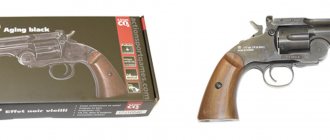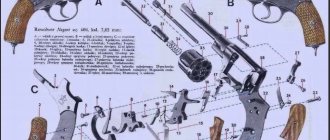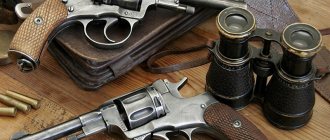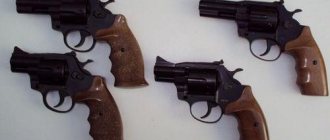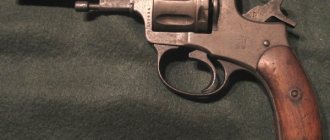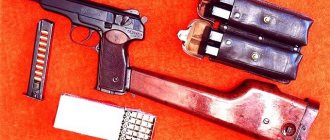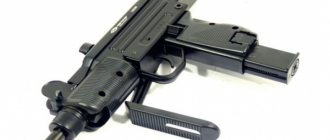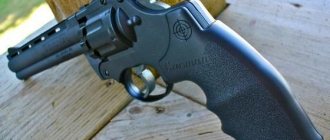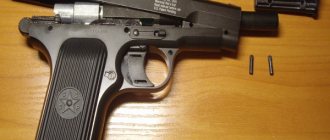The shot is produced by compressed gas
In pneumatic small arms, a bullet is thrown not under the influence of expanding hot gases formed by the explosion of a powder charge, but through the pressure of compressed air or carbon dioxide stored in a container. Depending on the principle of action of the energy source on the trigger mechanism, three types of these weapons are distinguished:
- In a spring-piston type, compressed air is generated due to the movement of a piston driven by a spring when the weapon is broken before firing or by a special lever. One of the subtypes is called multi-compression: air is pumped in several pumps.
- Pre-inflated weapons require air to be pumped into the tank using a compressor before firing.
- The gas cylinder uses carbon dioxide located in a tank or in a replaceable cartridge.
Pneumatic revolvers use a gas-cylinder type of mechanism. As a rule, such samples have a caliber of 4.5 mm (0.177 inches according to Western markings) and a muzzle energy of no more than 3 joules, which implies free sale in the Russian Federation. A pneumatic combat revolver is not suitable for hunting and is intended only for entertainment and sporting events.
Description
The Gletcher NGT Black pneumatic revolver is manufactured in Taiwan under license from the famous Gletcher brand. The main purpose of the model is training shooting at a shooting range, on a sports ground; it is not a military weapon, but an entertainment model. The modern original model of the Gletcher NGT pistol is very popular in the Russian Federation, as in the early period of its existence - during the First World War and the Soviet Union. This is the famous “Russian revolver”, which became the hallmark of the revolutionary years and the civil war in Russia.
With such a pistol in your hands, you can feel the atmosphere of a military situation, imagine yourself as a detective, a spy - after all, the revolver was a common type of personal weapon at one time. Being a copy of the historical model developed by the inventors Nagan brothers (Emil and Leon), the air pistol provides a full range of corresponding sensations - from tactile and visual to the effect of presence in the old era. The unit, weighing 700 g, pleasantly stretches the hand, and a large series of notches gives it a complete resemblance to the original.
Consumer characteristics of the model:
- the pistol is loaded exactly like the original;
- weight and appearance are also fully consistent with the original version;
- the authentic appearance gives the model an atmospheric feel; visual similarity to the historically famous revolver is also ensured by the priming screw;
- additional similarity is emphasized by false cartridges.
Design
The design of the gletcher ngt pneumatic revolver is made of very high quality carbon steel and has a black coating, plastic lining on the handle with wood stylization. The overlays give the effect of authenticity to the original metal product. The new product also has a rifled barrel—rifling contributes to shot accuracy, accuracy, and balance.
The clamping screw is hidden in the design of the model, which gives even greater originality to the entire revolver. The length of the revolver is 230 mm, the weight is similar to the original version - 700 g.
The basic package includes a revolver, 7 false cartridges, and a product passport.
The previous version of the Glatcher NGT R revolver acquired new modifications and updates due to the improvement of the fuse - the revolver’s service life and degree of reliability have increased.
This is the most successful version of the revolver from the American manufacturer, this is explained by the presence of a rubber insert for false cartridges on both sides, unlike other versions. This factor improves the tightness of the product.
The design has become more durable due to the spherical steel insert; it takes on the main load at the moment of the shot.
Performance characteristics
The power of the shot is ensured by the presence of a canister of carbon dioxide (CO2) - its volume is 12 g. The canister imparts 3 J of bullet power during firing, the charge receives about 115 meters per second of initial speed.
The innovation of the Gletcher NGT model is that the trigger mechanism has a double action (Double Action), due to which it is possible to fire a shot using the self-cocking or pre-cocking method. The main difference from the original is that it is not bullets that are inserted into the drum, but cartridges with explosive balls. The use of false cartridges completely imitates a real revolver, and the procedure for loading the weapon is absolutely realistic and corresponds to the combat analogues of a revolver.
- Shooting is carried out using lead bullets of 45 mm caliber.
- The sight range is 10 meters.
- Drum capacity – 7 bullets.
- Type of working bullets - explosive (in the form of balls).
- Manufacturer - Taiwan factory under license from SMG Inc. (USA).
- Product weight – 700 g.
- Pneumatic type - gas cylinder device.
- Cylinder type and weight – CO2, 12 g.
- Product length – 230 mm, barrel – 115 mm.
- Availability of Blowback – absent.
- Color – black, there is a silver version.
Pneumatic American Dream
One of the leading manufacturers of air guns is the American company Sport Manufacturing Group (SMG) Inc. The concern offers several dozen types of samples of various price categories, power and design: from exact copies to modern stylish models. The peculiarities of American legislation leave their mark. Different states have their own restrictions on power, some require that gas weapons be painted in colors different from combat ones, or even given a different appearance. In some regions, this type of weapon is generally prohibited. The gunsmiths took into account all the nuances of not only their country, but also the peculiarities of the Eurasian market. The richest range is produced under the Gletcher brand.
Leader in sales in the post-Soviet space
Since 2010, the company has been supplying its products to the CIS countries and Russia. The weapon is specially designed in accordance with domestic legislation. Due to the fact that free circulation of firearms is prohibited in our country, the company undertook an original marketing move. Gletcher products replicate as much as possible the operation of the mechanisms of military analogues: they are made of metal, the movable bolt imitates the shooting of the military original. Since 2011, customers have been offered a series called Russian Legends. All products are guaranteed for one and a half years. The vast majority of gas revolvers on the shelves are Gletcher products.
Weapons of the Russian Empire
In 1895, a revolver of the Belgian Nagant system was adopted by the Russian army. For decades, these weapons were the most popular in our country. SMG offered Russian customers a replica of the legendary revolver. Gletcher NGT Black (“Gletcher” revolver black) was recognized as the most popular gas weapon in 2012. The pneumatic revolver exactly matches its combat prototype in terms of weight and size parameters. The developers tried to ensure that the external similarity was almost one hundred percent. A copy of a revolver compares favorably with other products of the same brand, for example, Smith & Wesson series revolvers (Chinese blanks had American brand logos attached to them).
Gletcher NGT, pneumatic revolver. Performance characteristics
The weapon is made of silumin, the color is radically black, like blued steel. A small batch with silver plating was released. The plastic cheeks of the handle imitate wood and are made of very high quality. The characteristics are as follows:
- Curb weight – 700 g.
- Caliber - 4.5 mm.
- Maximum length - 230 mm.
- The initial speed of the bullet is 120 m/s.
- Muzzle energy – 3 joules.
- Magazine capacity – 7 rounds.
- Ammunition type: steel shot.
- The energy source is a CO2 reservoir.
Pneumatic revolver Gletcher NGT R / RF Black, bullet (Nagant)
Hello. I will bring a fresh revolutionary spirit. I offer a review from an ordinary buyer of a pneumatic revolver, a copy of the legendary Nagant. The Nagant was adopted by the Russian army in 1895. At first it was purchased at home - in Belgium, and then its own production was established. It cost 22 rubles at that time. Not a small amount of money in those days. A good cash cow then cost from 50 rubles. And since then, this revolver has enjoyed enormous popularity in Russia, and then in the USSR. Nagan became a household name and any revolver was called this word. You can write volumes about Nagant, so anyone who wants to get acquainted with this revolver in more detail, I refer you to one of the specialized sites. Well, now for purchase The subject is called: Gletcher NGT RF Black pneumatic revolver. It was made in Taiwan. Legal address in the USA. This model has a rifled barrel and is designed for firing lead bullets; there are cheaper modifications with a smooth barrel for pellets. They send the revolver in a branded box with printing, but without glamor. Moreover, there are imitation scuffs on the folds, supposedly the box is far from fresh, like from those times.
Here is a brief summary of the main characteristics. There is a warning that the revolver can cause damage at a distance of up to 320 m.
Inside we see a revolver and instructions. There is a hole for a box of bullets, but they are not included. There is an explosion on the back of the cover - a diagram that is absolutely useful during disassembly, and especially during assembly
Characteristics.
Manufacturer: Gletcher (USA / Taiwan) Warranty: 18 months Caliber: 4.5 mm (.177) Combat prototype: Nagant revolver, Nagant M1895 (Belgium) Operating principle (?): gas-cylinder pneumatics Energy source: 12-gram cartridges with CO2 gas Muzzle energy: up to 3 J Ammunition: 4.5 mm pneumatic bullets Magazine capacity: 7 Blowback: no Shot speed: 100 m/s Material: body, base - metal Trigger mechanism: double action Firing mode: semi-automatic Safety : non-automatic, flag Sights: non-adjustable rear sight and front sight Weaver / Picatinny rail: no Barrel type: rifled Length: 230 mm Weight: 700 g Equipment: revolver, 7 false cartridges, passport (instructions) Certificate
With a can and false cartridges it weighs 753 grams, exactly the same weight as a combat revolver.
The revolver body is made entirely of metal. The exception is the plastic cheeks on the handle, stylized as wood... On the left side it looks like a combat prototype. It differs from the real thing by the absence of traces of metal processing.
But on the right, the designers tried to ensure that the subject was not confused with its combat counterpart. Here we see a safety lever, which is not present on a real revolver. The screws at the handle have a hexagonal slot, which the prototype naturally did not have, since they were not yet used in those days. The subject is also distinguished from the real one by the absence of a long beak-striker on the trigger.
The revolver receives energy for firing from a canister filled with compressed carbon dioxide. The canister is placed in the handle and, for puncture, is clamped with a special screw that doubles as a swivel. There is enough gas for about 80 shots.
For the most realistic use, the design includes false cartridges that imitate these revolver cartridges with a 7.62-38 bullet recessed into the sleeve.
The false cartridges, although brass, are overly polished, are loaded with lead bullets of 4.5 mm caliber.
They are inserted into the drum like in a real revolver. And to prevent the cartridges from falling out, the chambers are closed with a door.
To remove the cartridges, the door opens and the cartridges fall out one at a time as the drum rotates. In a real revolver, the cartridges are removed using a cleaning rod-extractor.
Incomplete disassembly is the same as in the combat counterpart. The cleaning rod-extractor is pulled out, freeing the drum axis, the axis is removed and the drum is removed.
Photo from the ratchet wheel side. The drum weighs 150 grams.
At the exit of the chambers, a chamfer has been removed for closer contact of the spring-loaded barrel. This is done to reduce gas losses when firing. When the drum is turned, the barrel is inserted into the next chamber each time, on the contrary, as in a real revolver - there the drum is pressed against the barrel. Because of this feature, you will not be able to spin or rattle the drum freely (as when playing Russian roulette).
The spring-loaded barrel consists of two parts - a rifled one and a smooth one with a larger diameter. Here is a fragment of the explosion diagram. The rifling gives the bullet a rotational movement, then it flies without touching the walls, that is, it does not lose speed from friction and at the same time in a straight line along the axis of the barrel thanks to the air cushion created in the narrow channel.
Barrel from the drum side
If you look into the muzzle (simply the muzzle), you can see the rifled part of the barrel, and in front of it a smooth part of a larger diameter.
The exhaust valve hole is visible here.
You can shoot in semi-automatic mode and with the hammer pre-cocked. In the latter case, it is easier to pull the trigger and, accordingly, hitting the target is better. How does a shot occur? The gas cylinder is clamped with a screw, and thereby pierced with a hollow needle. The liquefied gas turns into a gaseous state and enters the dispenser closed by a valve. In order for a shot to occur, you need to press on the valve stem, and this pressure must occur in a fraction of a second, while opening the valve as much as possible so that the gas release rate is also maximum. Here we see the valve stem.
When the trigger is pulled, the hammer hits the stem and the valve opens. But we see that the trigger and the rod are not in contact.
Everything here is done cleverly. To make an instant impact on the rod, a hammer is built into the trigger. When descending, it jumps out and hits the rod.
As I already said, the revolver is made of a metal alloy, only it is not silumin, as they say on the forums. The subject is made of zinc alloy ZAMAK (domestic abbreviation TsAM), its base is about 90-95% zinc, depending on the brand of alloy, with the addition of alloying elements - aluminum, magnesium, copper. The alloy is quite fusible - the melting point is from 380 degrees.
The Nagan is not a fast-reloading weapon. It does not have clips that can be instantly rearranged. Nevertheless, the charging process here is the ritual for which they buy a revolver. You can, of course, load bullets without removing the false cartridge from the drum.
I loaded the weapon, now I’ll test the revolver in shooting. I checked the accuracy at a distance of 6 meters. I think it’s good.
This revolver shoots bullets, and bullets do not break glass containers as effectively as balls. Therefore, if you plan to shoot at bottles, it is better to take the variety for balls, without the letter R. It is also ten bucks cheaper. But if you really want to, you can also shoot with balls, but there is a chance that they will break the rifling of the barrel and the shots will not be so accurate. In addition to ordinary lead bullets, you can shoot light-noise bullets of the “Blik” type, as well as pneumatic darts. The revolver is specially designed for darts; you can load seven of them at once.
Here I shot almost without aiming, checking the quality of the darts. As you can see, the plumage of the last one fell off. You need to look for a softer board, or use a dartboard, otherwise you won’t pull out the darts. The only annoying drawback in the revolver is the play of the false barrel. Yes, the outer barrel is not real, it only covers the spring-loaded barrel located inside. The false barrel is held on by one pin, hence the play. When the opportunity arises, I will certainly correct this shortcoming. I will also replace the screws, remove the unnecessary fuse, and erase the white inscriptions. . That's all. Thank you for your attention.
Action of the mechanism
The Gletcher pneumatic revolver reproduces a firearm revolver as closely as possible. The trigger mechanism allows firing both by self-cocking and with manual pre-cocking of the hammer. It differs from the original in that the drum is stationary during the shot, that is, it does not slide along the barrel, but the barrel itself is spring-loaded. This was done for more effective sealing and to prevent gas breakthrough during firing. As on the combat counterpart, the drum is removed from the frame. There is a manual safety on the body that blocks the hammer and trigger.
Upgrade
Improving the performance of a pistol usually requires increasing the power. This will increase the shot speed, which depends on the chamber capacity and spring replacement. Accordingly, the following manipulations can be carried out:
- expansion of the pneumatic chamber after processing it on a special lathe. They remove a small layer of metal, lengthen the barrel by carefully installing it so that accuracy is not affected during further shooting;
- install a stronger spring - for this they take a slightly longer copy against the background of the factory one, 2-3 turns of extra length are enough. When folded, it should fit into the container when cocked;
- place a metal washer, suitable in size, under the spring - this lining holds the spring in a compressed state and provides stronger resistance when cocking the weapon.
These simple methods can significantly increase the power of the Gletcher NGT pistol.
Equipment with cartridges
Metal shot coated with a layer of copper is used as ammunition. To prepare for shooting, bullets should be secured in false cartridges. The NGT pneumatic revolver uses original ammunition, other models will not work. The loading procedure is the same as the original: cartridges are inserted one at a time into the drum while rotating clockwise, just like a real firearm. When loading a cartridge, the bullet must be immersed until it makes a characteristic click. The recessed shot should be flush with the rubber pad. The peculiarity of the false cartridges is that two rubber inserts are pressed into them: in the front part and at the end. This ensures minimal gas losses. The drum mechanism is not folding. The gas cylinder is placed in the handle and covered with a plastic cover. The clamping screw is disguised as a trench coat.
Disassembly and care
The Gletcher NGT air revolver model requires standard care. As with other pneumatic pistols, regular cleaning and lubrication using special oils and blowing are required.
Disassembly is performed in the following order:
- before starting work, remove the cylinder, magazine, remove the cheeks of the handle;
- using an awl, squeeze out the pins in the front part of the barrel, remove them and set them aside;
- move the shutter to its extreme position, holding the plug (being careful - it can jump out under the action of the spring). Then remove the spring;
- hold the bolt at the rear in the extreme position, move it forward, remove the bolt.
This is an incomplete disassembly, which is enough for everyday weapon care. For complete disassembly, you need to unscrew all the bolts with a screwdriver, remove and separate all components for lubrication and cleaning.
The pistol is maintained using special brushes for cleaning 45-caliber pneumatic guns. Usually the set contains several brushes and rollers of different hardness, which are screw-on cleaning rods. Pneumatic oil is used as a lubricant. It utilizes the lifespan of both pistols and shotguns and also increases shot accuracy.
For simple cleaning and lubrication, simply remove the false cartridges, oil the roller on the holder and remove the drum from the gun. The roller is inserted into the barrel of the model, and cleaning and lubrication are carried out simultaneously. It is important that the cleaning rod does not get stuck or become bent during cleaning. Excess oil is removed with blotting paper. Then the drum is returned to its place and the pistol is loaded.
The lubricant allows you to fill in abrasions and any small roughness, which increases the speed and accuracy of shooting. Simply pouring oil into the barrel is not recommended, as it will interfere with cleaning of excess.
Shooting from a pneumatic revolver
The gas reserve in one cylinder is enough for 105 shots (15 loaded drums). This figure is significantly higher than that of other similar products. Over the course of 60 shots, the bullet flight speed of 120 m/s declared by the manufacturer is maintained, and then the indicators drop to 85 m/s and below. We are talking about using a spherical explosive bullet. The self-cocking trigger force is about 3 kg, three times lighter than the analogue, which is very comfortable to use and has a positive effect on shooting accuracy. Accuracy is within normal limits for this type of small arms.
Historical replica - Crosman 36
The Crosman 36 is an exact replica of the 1873 Colt.
The rather unusual design repels buyers, but those who still risk purchasing the model will be pleasantly surprised, because the weapon has several features:
- Location of the carbon dioxide cylinder. Unlike most models, in which the gas supply is hidden in the handle, here it is placed under the barrel.
- Special loading system. Thanks to the unusual combination of a linear under-barrel magazine and drum, the model can be equipped with 18 bullets, which reliably enter the barrel.
But, unfortunately, this weapon (pneumatic) has joined the list of models that have long been discontinued. In Russia there are practically no working models to be found, but abroad they can still be found in specialized stores.
Borner revolvers
The leading manufacturer specializing in air guns is the American company Central Bornership Company (CBC) Inc. The products are manufactured under the Borner brand. The company entered the domestic market in 2011. The high quality of the products is evidenced by the fact that Gletcher and Crosman acquire licenses for the production of some samples. The flagship line of revolvers is represented by three smooth-bore models with similar parameters:
- Pneumatic revolver Borner Super Sport 708: weight - 1020 g, drum capacity - 6 cartridges for explosive bullets, initial bullet speed - 120 m/s, prototype - Smith & Wesson in the Military Police version. It is possible to install a collimator or optical sight.
- Super Sport 703 is a very powerful pneumatic revolver: weight - 1040 g, drum capacity - 6 explosive bullets, bullet flight speed - up to 135 m/s, barrel length - 8 inches (203 mm), does not have a combat prototype. The design allows for the installation of sights. Very convenient for aimed shooting.
- Super Sport 705: weight - 650 g, flight speed - up to 130 m/s, drum capacity - 8 explosive bullets, barrel length - 4 inches (102 mm). The appearance is stylized to match the dimensions of the Smith & Wesson model. The developers have provided for the installation of a collimator or optical sight.
Also popular are the eight-shot Super Sport 705 (weight - 700 g, six-inch barrel), the six-shot 702 model weighing 900 g. All samples include the use of false cartridges and are equipped with a drum tilting mechanism.
ASG Dan Wesson 6
The presented model of a pneumatic revolver is an exact copy of the Dan Wesson Magnum. The chrome-plated barrel is striking in its beauty, made of silumin. The handle is covered with plastic pads that slide back and provide access to the carbon dioxide cylinder.
But experts warn: the design of this pneumatic revolver is not very reliable. The retractable linings are easy to break off, and the silumin pins holding the barrel casing are quite fragile - over time the barrel will become loose and accuracy will decrease.
The side-folding drum, which is equipped with 6 false cartridges, is a pleasure. To speed up reloading, the weapon comes with an extractor. The trigger mechanism also pleases consumers - the hammer can be cocked with a finger or by pressing the trigger.
Rifled brothers
A type of weapon that uses the kinetic energy of expanding cold gases to fire is a rifled pneumatic revolver. The rifled barrel provides greater accuracy and accuracy of fire. In this niche, Gletcher offers a replica of one of the models of the famous Smith & Wesson revolver. The model is called Gletcher SW R6, in the basic version it is equipped with a rifled barrel made by German Lothar Walther. The owners note a fairly accurate imitation of the execution and the realism of the shooting process. The folding drum completes this effect. The flight speed of a steel bullet is 120 m/s. However, the use is slightly overshadowed by the need for additional equipment for false cartridges: a round steel bullet must be removed and a lead one inserted. Samples with a Umarex barrel have a higher cost.
It should be said that rifled weapons are very expensive. Not all leading brands have similar pneumatic revolvers in their product range. The most powerful representative of this class is the Vigilante from the Crosman weapons company. Model 357-6 does not have a combat prototype, but is vaguely reminiscent of the firearm Stealth Hunter from the same Smith & Wesson company. The manufacturer states that when firing explosive ammunition, the bullet's flight speed is 140 m/s. This revolver is omnivorous: a 10-round drum is designed for firing lead bullets, and a 6-round drum for shooting pellets. True, not the whole drum, but its moving segment. The 6-inch (152 mm) barrel contributes to high shooting accuracy.
Advantages and disadvantages
The advantages of this model include:
- almost complete external correspondence to the original version of the military weapon;
- transferring close to real sensations when shooting;
- easy to maintain, upgradeable.
Flaws:
- similarity to the original damages combat characteristics: the power of the shot and the accuracy of fire in general are reduced;
- more suitable for connoisseurs of historical weapons than for sporting achievements.
Which revolver is the most powerful?
To summarize, we can say that the products of different companies are almost identical. The same energy source is used, the same ammunition is used, and the mechanical parts are similar. The only difference is in the quality of execution and external design. The most powerful models are those with a barrel length of 8 inches (203 mm). As a rule, for these samples the initial bullet speed reaches 140 m/s, while the standard speed stated in the passport is 120. In these indicators, gas-cylinder weapons are significantly inferior to spring-fracture weapons and those with pre-pumping, in which the bullet speed reaches 210 m/s and even more, and the muzzle energy is the maximum permissible by law 7.5 joules. The record holder is Zoraki Hp-01 Light - a Turkish air pistol. The revolver does not appear on these lists. And not only due to its design features, which do not allow one to disguise the bulky piston mechanism. These weapons serve other purposes, primarily aesthetic ones. In ballistic terms, an air revolver is inferior to a pistol.
Types of revolvers by design
According to their design, pneumatic revolvers are divided into weapons with a rifled and smooth barrel. The first type has a clockwise spiral rifling that twists the bullet. Thanks to rotation, it stabilizes in the vertical plane, which increases the accuracy and accuracy of fire.
Almost all air pistols and revolvers have a principle of operation based on the ability of gas to quickly expand. After installing the cylinder and preparing the weapon for firing, carbon dioxide partially fills a special expansion chamber with a dispenser valve.
At the moment of firing, the valve opens and releases carbon dioxide, which, constantly expanding, pushes the projectile forward and gives it initial acceleration. If false cartridges are used as bullets, then the gas enters directly into the cavity of the cartridge.
